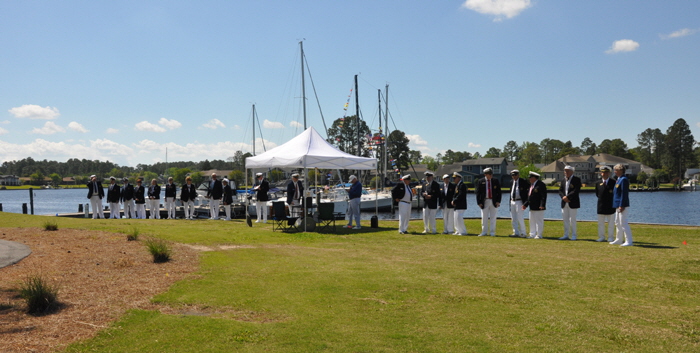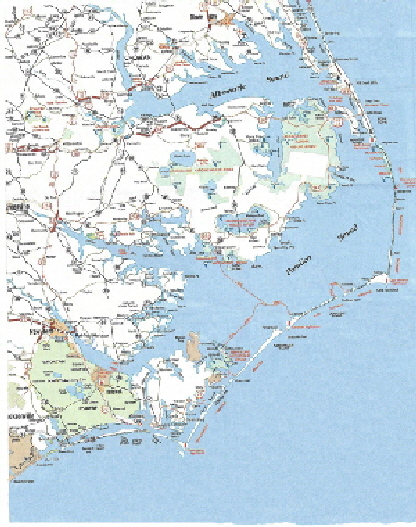 Every spring the Fairfield Harbour Yacht Club (FHYC) stages a fleet review to mark the official start of the sailing season in the Pamlico Sound region of North Carolina. This year it attracted 22 vessels of all shapes and sizes, including my brigantine schooner Britannia. We had only recently moved to Fairfield harbour and this was our first outing as new members of FHYC.
Every spring the Fairfield Harbour Yacht Club (FHYC) stages a fleet review to mark the official start of the sailing season in the Pamlico Sound region of North Carolina. This year it attracted 22 vessels of all shapes and sizes, including my brigantine schooner Britannia. We had only recently moved to Fairfield harbour and this was our first outing as new members of FHYC.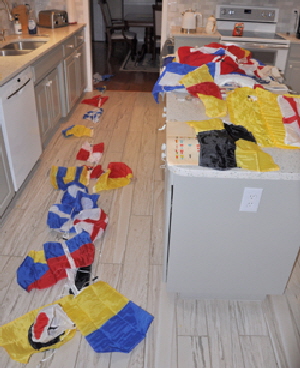 Pamlico Sound and the smaller Albemarle Sound are very large inland seas on the eastern shores of North Carolina. It is the second largest inland water in America next to The Chesapeake Bay. The area is protected from the Atlantic Ocean by a string of barrier islands with well known names like Kitty-hawk, (of Wright Brothers fame); Ocracoke, (of the pirate Blackbeard’s notoriety) and Cape Hatteras with its dreaded offshore Diamond Shoals. Fairfield Harbour is some 60 nautical miles to the west near New Bern, that is the largest town of the region. It is on the wide Neuse River that feeds into Pamlico Sound, and the whole region is a mecca for boaters and fishermen.
Pamlico Sound and the smaller Albemarle Sound are very large inland seas on the eastern shores of North Carolina. It is the second largest inland water in America next to The Chesapeake Bay. The area is protected from the Atlantic Ocean by a string of barrier islands with well known names like Kitty-hawk, (of Wright Brothers fame); Ocracoke, (of the pirate Blackbeard’s notoriety) and Cape Hatteras with its dreaded offshore Diamond Shoals. Fairfield Harbour is some 60 nautical miles to the west near New Bern, that is the largest town of the region. It is on the wide Neuse River that feeds into Pamlico Sound, and the whole region is a mecca for boaters and fishermen.
My wife Kati and I had spent all the preceding day sorting out our flags and tying them together to make Britannia look her best. She is British registered, so naturally our most prominent flag was the “Red Duster,” that measures 5’ x 10’ feet.
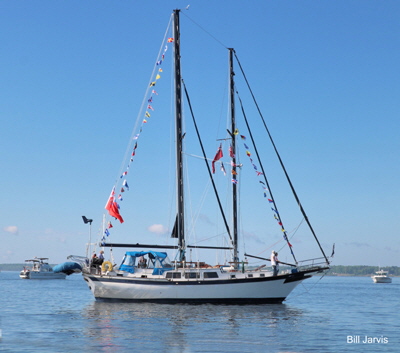 The muster point for the fleet was outside the actual harbor in the Neuse River, where it was planned that boats should form “line astern,” then steam slowly up Spring Creek, a narrow canal into the main lagoon. I had some reservations about this plan due to Britannia's 6’ 6” draft. The water is rather shallow at the muster point and very susceptible to wind, that in certain directions can push water out of the lagoon and reduce the levels significantly. It would have been the height of ignominy to run aground on our first public excursion, in front of the whole club.
The muster point for the fleet was outside the actual harbor in the Neuse River, where it was planned that boats should form “line astern,” then steam slowly up Spring Creek, a narrow canal into the main lagoon. I had some reservations about this plan due to Britannia's 6’ 6” draft. The water is rather shallow at the muster point and very susceptible to wind, that in certain directions can push water out of the lagoon and reduce the levels significantly. It would have been the height of ignominy to run aground on our first public excursion, in front of the whole club.
My other concern was maneuvering my 50’ foot schooner amongst so many other craft, that I was told could become a bit like the start of a yacht race. Britannia is also 25’ feet wide, that is when you glance upwards at the yard that carries the squaresail on the foremast. Skippers of “normal” sailboats don't worry much about passing other boats close to, but you can't do that with a square rigger even if she does only sport a single yard. I have frequently had to hail other boats, warning them not to pass too closely, and point to the yard sticking out up the forward mast. I need not have worried on this occasion though, because it was flat calm at 0830 on the day of the review, and boats kept well clear of each other 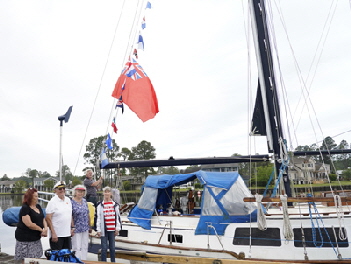 as we all waited to join our position in the procession.
as we all waited to join our position in the procession.
A protocol was to be observed in the line, headed by the Commodore's boat, followed by the club directors, then previous Commodores and finally club members in their boats. I had invited our friends Lynn and George Stateham to join us and George just happened to be a previous commodore, so being the largest sailboat in the fleet Britannia headed the Commodore's line behind the officials’ boats. Our other guests were Stan and Laurie Eakins. Stan is an accomplished photographer and I had asked him if he would take pictures for this article, as I expected to be managing Britannia most of the time.
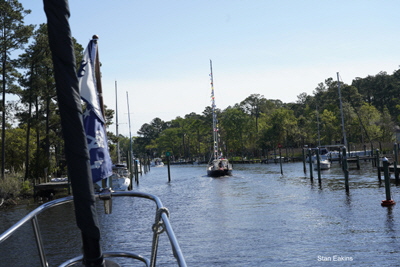 It was quite a spectacle as we joined the line and began to steam slowly up Spring Creek. The creek is boarded on both sides by some very large homes, all with private docks and some impressive machinery moored at the bottom of the garden. As the creek opens up into the large Fairfield Harbour lagoon there is a dog leg to negotiate that is not very well marked and where I was warned the water on either side might be only 4’ feet deep. George, navigated us expertly through this section, and we entered the inner harbor proper.
It was quite a spectacle as we joined the line and began to steam slowly up Spring Creek. The creek is boarded on both sides by some very large homes, all with private docks and some impressive machinery moored at the bottom of the garden. As the creek opens up into the large Fairfield Harbour lagoon there is a dog leg to negotiate that is not very well marked and where I was warned the water on either side might be only 4’ feet deep. George, navigated us expertly through this section, and we entered the inner harbor proper.
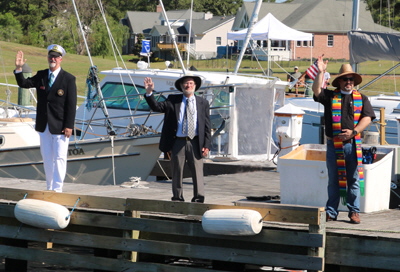 The next stage of the proceedings was the “Blessing of the boats,” as they each steamed passed the local clergy gathered on the end of the small marina dock that is normally Britannia’s home. The club chaplain was there along with a local Episcopalian clergyman, and a Rabbi, presumably covering most religions in the club. I said I would be happy to fall within the Episcopalian denomination that is as near as you can get in America to the Church of England.
The next stage of the proceedings was the “Blessing of the boats,” as they each steamed passed the local clergy gathered on the end of the small marina dock that is normally Britannia’s home. The club chaplain was there along with a local Episcopalian clergyman, and a Rabbi, presumably covering most religions in the club. I said I would be happy to fall within the Episcopalian denomination that is as near as you can get in America to the Church of England.
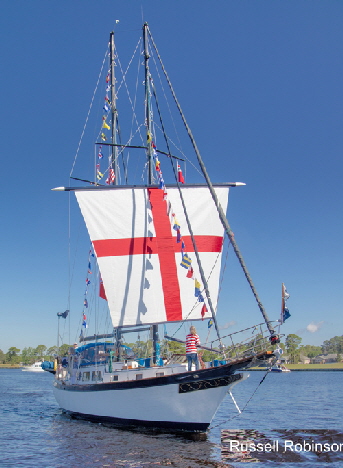 Everyone received their respective blessings as they steamed slowly past and up to the head of the lagoon where, we turned round to come back down. It was at this point that I mentioned to George about Lord Nelson's immortal words as the British fleet bore down upon the combined French and Spanish ships off Cape Trafalgar in1805. “I shall now amuse the fleet.” George had no idea what to expect, but instead of hoisting Nelson's signal “England expects that every man will do his duty.” (that we didn't have enough flags for anyway), I unfurled the large squaresail on Britannia’s foremastm with its prominent red Cross of St, George, the patron saint of England emblazoned on it. It is also the national flag of England forming the base part of the Union Jack, the other two being the flags of Scotland and Ireland superimposed.
Everyone received their respective blessings as they steamed slowly past and up to the head of the lagoon where, we turned round to come back down. It was at this point that I mentioned to George about Lord Nelson's immortal words as the British fleet bore down upon the combined French and Spanish ships off Cape Trafalgar in1805. “I shall now amuse the fleet.” George had no idea what to expect, but instead of hoisting Nelson's signal “England expects that every man will do his duty.” (that we didn't have enough flags for anyway), I unfurled the large squaresail on Britannia’s foremastm with its prominent red Cross of St, George, the patron saint of England emblazoned on it. It is also the national flag of England forming the base part of the Union Jack, the other two being the flags of Scotland and Ireland superimposed.
This immediately started cameras clicking because nobody had hoisted sails in the review before and the slight wind would have caused a Bermudian sail to flap about limply. But a squaresail is attached at its head to the yard and anchored with two sheets at the foot, so it can be securely held. I had been watching the wind direction anyway and the sail only filled a little and didn't upset the 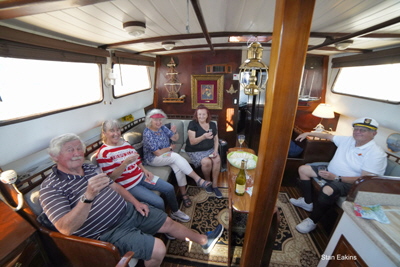 steering of Britannia at all. I was also able to unfurl this large sail on my own, because I had designed it to roll up inside the hollow yard and be furled and unfurled from the cockpit. As we approached the end of the lagoon I rolled the sail back up and it disappeared as quickly as it had appeared.
steering of Britannia at all. I was also able to unfurl this large sail on my own, because I had designed it to roll up inside the hollow yard and be furled and unfurled from the cockpit. As we approached the end of the lagoon I rolled the sail back up and it disappeared as quickly as it had appeared.
We then turned and motored back to our dock, where I served British Navy grog and bottles of wine were opened, toasting to a successful “maiden voyage”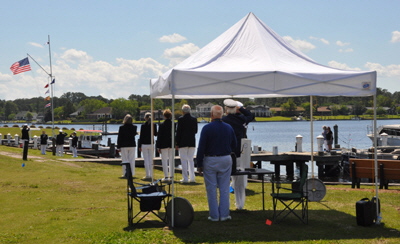
Later, when all the officials had docked their boats and assembled on the shore, a commissioning ceremony was held to mark the official start of the sailing season, and announce the many group cruisers, races and regattas to be held during the summer. The start cannon was fired and the club's colors and the Stars and Stripes were hoisted to the tune of “The Star Spangled Banner.” A wreath was also cast into the water, in memory of those members who had passed away during the year, and the club's bell ceremoniously stuck as each name was memorialized.
Everyone then made their way to the local community center, where a luncheon had been arranged and the drinks flowed freely. I was quite amazed at how many people told me how delighted they were with my little sail demonstration, and how amazed they were when the sail suddenly appeared as if out of nowhere.
We now look forward to exploring this vast inland sea, with its many large rivers and creeks and reporting on its diversity and early colonial history. However, I will still maintain my membership to Tow Boat US, just as insurance against those unmarked shallows I have been warned about.
